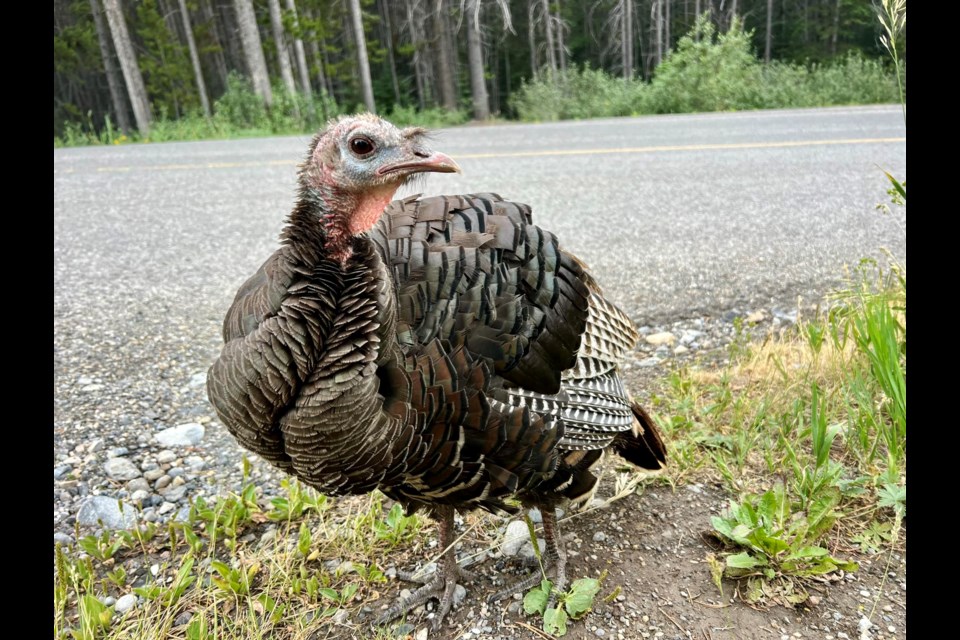KANANASKIS COUNTRY – Wild turkeys are trotting around Kananaskis Country.
Repeated sightings of at least one wild turkey – a hen – have been reported in Peter Lougheed Provincial Park, a fair distance from typical turkey range in the province.
“It’s about 50-60 kilometres from the nearest location where we’ve released turkeys,” said Alberta Conservation Association (ACA) president and CEO Todd Zimmerling.
“It’s not banded, so it’s not one of the ones we released, but it’s possible it could be a young [turkey] from one that we have released. Or, possibly, it could have been released from a local landowner in the area as well. It’s really hard to tell. But as you can surmise, it’s fairly rare to see turkeys in that area.”
Mike Dallison was camping at the Kananaskis Interlakes Campground in mid-July when he spotted a hen following him back to his site.
“She was overly friendly. I had to keep backing away from her. Sadly, people must be feeding her,” he said.
“She was chatting away the whole time.”
Dallison said he was told by the campground host and employees of the nearby Boulton Creek Campground store that there may be more than one turkey roaming the area based on sightings – including a male.
The ACA is managing a 10-year plan to relocate wild turkeys from other regions over the next decade to establish a sustainable population in Alberta. In 2022, a management plan for wild turkeys was introduced for the province.
The conservation organization has been releasing birds over the last two winters, into early spring. Working with landowners, wild turkeys are dispersed from Black Diamond south to near Waterton Lakes National Park.
Alberta Forestry and Parks said the ACA and its partners translocated 177 wild turkeys to Alberta from B.C. in 2023. So far in 2024, 183 wild turkeys have been translocated from B.C. to southwestern Alberta.
The ministry confirmed more than one turkey has recently been spotted in Kananaskis.
“We cannot confirm if the wild turkeys spotted in Peter Lougheed Provincial Park are part of this project or if the turkeys were transported into the park by other means,” said Alberta Forestry and Parks press secretary Pam Davidson, in a statement.
It is not out of the question that a young turkey from a brood further south may have taken a strut up north, says Zimmerling.
“Certainly, in summertime, there’s nothing that prevents that turkey from going for a wonder just about anywhere. They’ll feed heavily on berries and other plant materials. So, they might very well wander up into the alpine, like any young turkey will go a long way without knowing where it’s going or why,” he said.
The hefty birds can fly short distances, but to hunters, are better known as fast walkers. According to the U.S. Fish and Wildlife Service, turkeys can clock 29 kilometres per hour on foot and up to 80 kilometres per hour in flight.
“It wouldn’t be impossible to see how turkeys move 50 kilometres in a summer. We’ve seen some turkeys released in one location and then a couple weeks later they’ve been found 20 kilometres away. Just how much of that they flew or how much they walked, who knows, but they can cover some ground fairly quickly,” said Zimmerling.
Wild turkeys are not native to Alberta, but historically have been found across the eastern United States and up into Ontario.
By the early 1900s, overhunting and habitat destruction had wiped out wild turkeys from much of their original North American range.
Habitat restoration and reintroduction efforts have led to wild turkeys re-occupying their original range and establishing populations in new areas. The birds now occupy all 48 lower U.S. states, as well as British Columbia, Alberta, Saskatchewan, Manitoba and Ontario.
Introduction of the species in Alberta dates back to the 1960s. In its 2022-23 report, the ACA estimated 790 wild turkeys in the province, following their introduction in 1962.
“There’s a keen interest in turkeys and in Alberta. What we found was it became a really big interest in harvesting turkey. We’re over 10,000 people applying to harvest a turkey every spring. Last year, around 100 turkey tags were issued. So, if you think of the number of people trying to apply to hunt just 100 turkeys, you can see there is a huge demand,” said Zimmerling.
“That’s part of why we got involved in trying to expand the turkey range, increasing their numbers and to try to get some more information on what may be limiting their growth as a population in Alberta – is it predator issues, habitat issues, is it just a matter of our winters knocking them back too often?”
In winter, turkeys tend to seek out areas with large roost trees, often conifers.
Typically, the species bodes well along the eastern slopes where habitat also overlaps with agriculture activities, particularly ranching. The birds will take advantage of any leftover livestock feed for sustenance, especially during a rough winter.
Based on where the confirmed hen in Kananaskis keeps turning up in sightings reported on social media, near popular visitor areas like campgrounds and lakes, Zimmerling guesses it could be getting fed by people.
“That’s probably why it’s hanging around there and once campgrounds and those areas start to shut down, then that turkey’s got to figure out where it’s going to get its next meal as winter starts rolling in,” he said. “I’m curious to see if it does decide to move out toward some more agricultural areas where it has more food sources to feed on.”
Alberta Parks is asking members of the public to report wild turkey sightings to Kananaskis Emergency Services at 403-591-7755.
The Local Journalism Initiative is funded by the Government of Canada. The position covers Îyârhe (Stoney) Nakoda First Nation and Kananaskis Country.




